Critical Care Analysis for Acute Patient
VerifiedAdded on 2023/04/07
|12
|2533
|136
AI Summary
This essay provides a critical analysis of the treatment approach used for a patient suffering from acute coronary artery disease, including pathophysiology, treatment, and psychosocial approach. It also discusses the priorities of nursing care for managing the patient's chest discomfort.
Contribute Materials
Your contribution can guide someone’s learning journey. Share your
documents today.
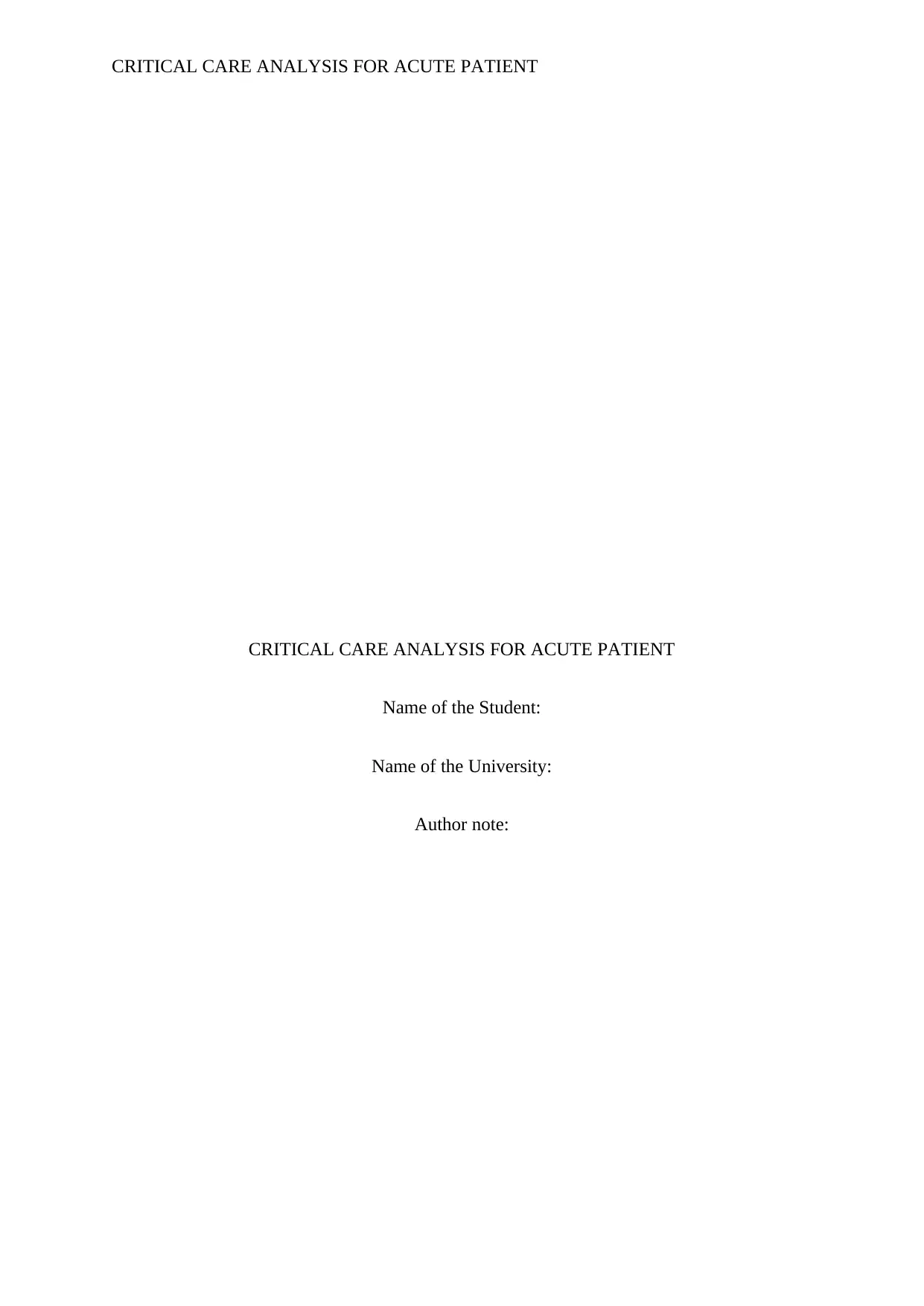
CRITICAL CARE ANALYSIS FOR ACUTE PATIENT
CRITICAL CARE ANALYSIS FOR ACUTE PATIENT
Name of the Student:
Name of the University:
Author note:
CRITICAL CARE ANALYSIS FOR ACUTE PATIENT
Name of the Student:
Name of the University:
Author note:
Secure Best Marks with AI Grader
Need help grading? Try our AI Grader for instant feedback on your assignments.
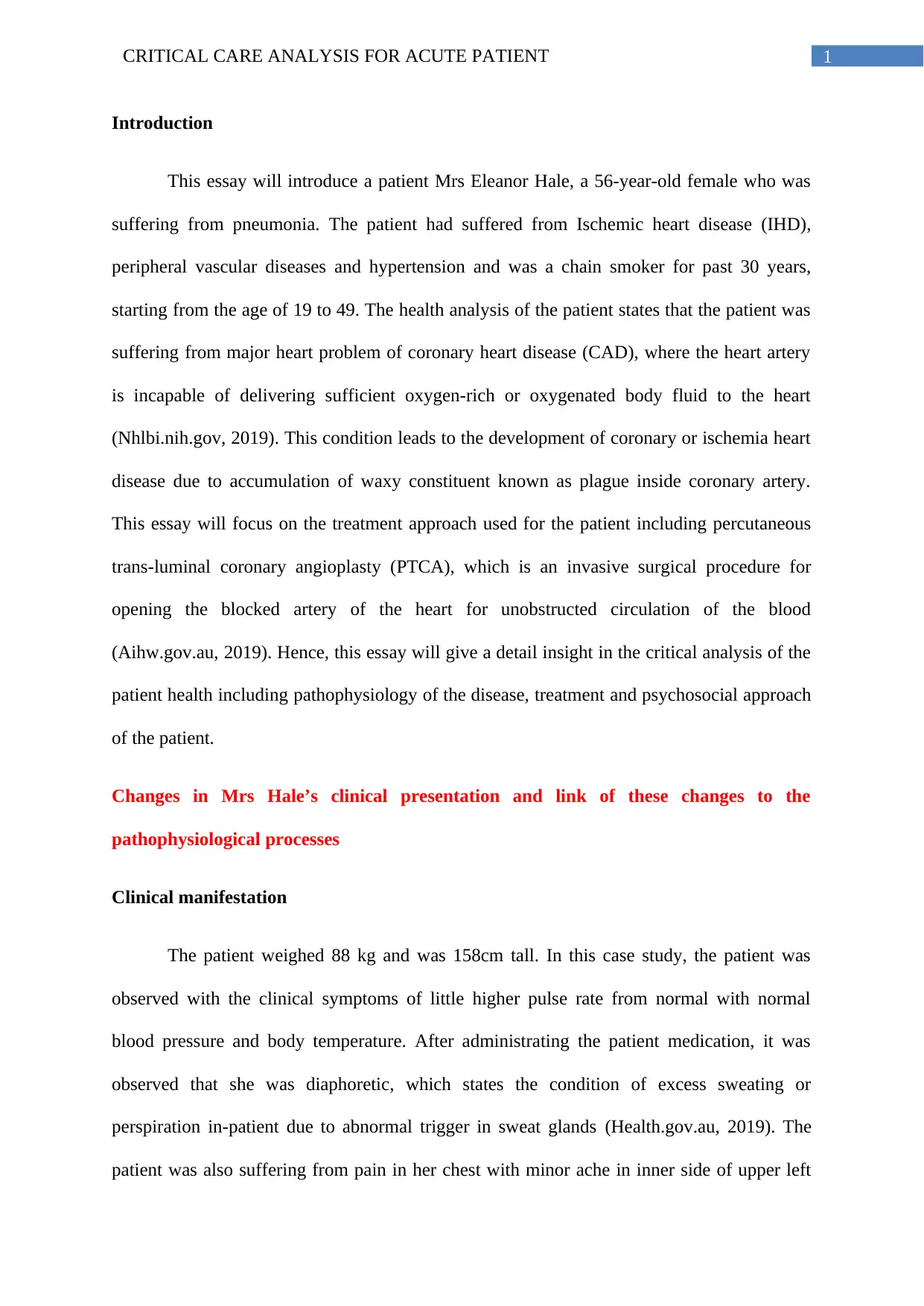
1CRITICAL CARE ANALYSIS FOR ACUTE PATIENT
Introduction
This essay will introduce a patient Mrs Eleanor Hale, a 56-year-old female who was
suffering from pneumonia. The patient had suffered from Ischemic heart disease (IHD),
peripheral vascular diseases and hypertension and was a chain smoker for past 30 years,
starting from the age of 19 to 49. The health analysis of the patient states that the patient was
suffering from major heart problem of coronary heart disease (CAD), where the heart artery
is incapable of delivering sufficient oxygen-rich or oxygenated body fluid to the heart
(Nhlbi.nih.gov, 2019). This condition leads to the development of coronary or ischemia heart
disease due to accumulation of waxy constituent known as plague inside coronary artery.
This essay will focus on the treatment approach used for the patient including percutaneous
trans-luminal coronary angioplasty (PTCA), which is an invasive surgical procedure for
opening the blocked artery of the heart for unobstructed circulation of the blood
(Aihw.gov.au, 2019). Hence, this essay will give a detail insight in the critical analysis of the
patient health including pathophysiology of the disease, treatment and psychosocial approach
of the patient.
Changes in Mrs Hale’s clinical presentation and link of these changes to the
pathophysiological processes
Clinical manifestation
The patient weighed 88 kg and was 158cm tall. In this case study, the patient was
observed with the clinical symptoms of little higher pulse rate from normal with normal
blood pressure and body temperature. After administrating the patient medication, it was
observed that she was diaphoretic, which states the condition of excess sweating or
perspiration in-patient due to abnormal trigger in sweat glands (Health.gov.au, 2019). The
patient was also suffering from pain in her chest with minor ache in inner side of upper left
Introduction
This essay will introduce a patient Mrs Eleanor Hale, a 56-year-old female who was
suffering from pneumonia. The patient had suffered from Ischemic heart disease (IHD),
peripheral vascular diseases and hypertension and was a chain smoker for past 30 years,
starting from the age of 19 to 49. The health analysis of the patient states that the patient was
suffering from major heart problem of coronary heart disease (CAD), where the heart artery
is incapable of delivering sufficient oxygen-rich or oxygenated body fluid to the heart
(Nhlbi.nih.gov, 2019). This condition leads to the development of coronary or ischemia heart
disease due to accumulation of waxy constituent known as plague inside coronary artery.
This essay will focus on the treatment approach used for the patient including percutaneous
trans-luminal coronary angioplasty (PTCA), which is an invasive surgical procedure for
opening the blocked artery of the heart for unobstructed circulation of the blood
(Aihw.gov.au, 2019). Hence, this essay will give a detail insight in the critical analysis of the
patient health including pathophysiology of the disease, treatment and psychosocial approach
of the patient.
Changes in Mrs Hale’s clinical presentation and link of these changes to the
pathophysiological processes
Clinical manifestation
The patient weighed 88 kg and was 158cm tall. In this case study, the patient was
observed with the clinical symptoms of little higher pulse rate from normal with normal
blood pressure and body temperature. After administrating the patient medication, it was
observed that she was diaphoretic, which states the condition of excess sweating or
perspiration in-patient due to abnormal trigger in sweat glands (Health.gov.au, 2019). The
patient was also suffering from pain in her chest with minor ache in inner side of upper left
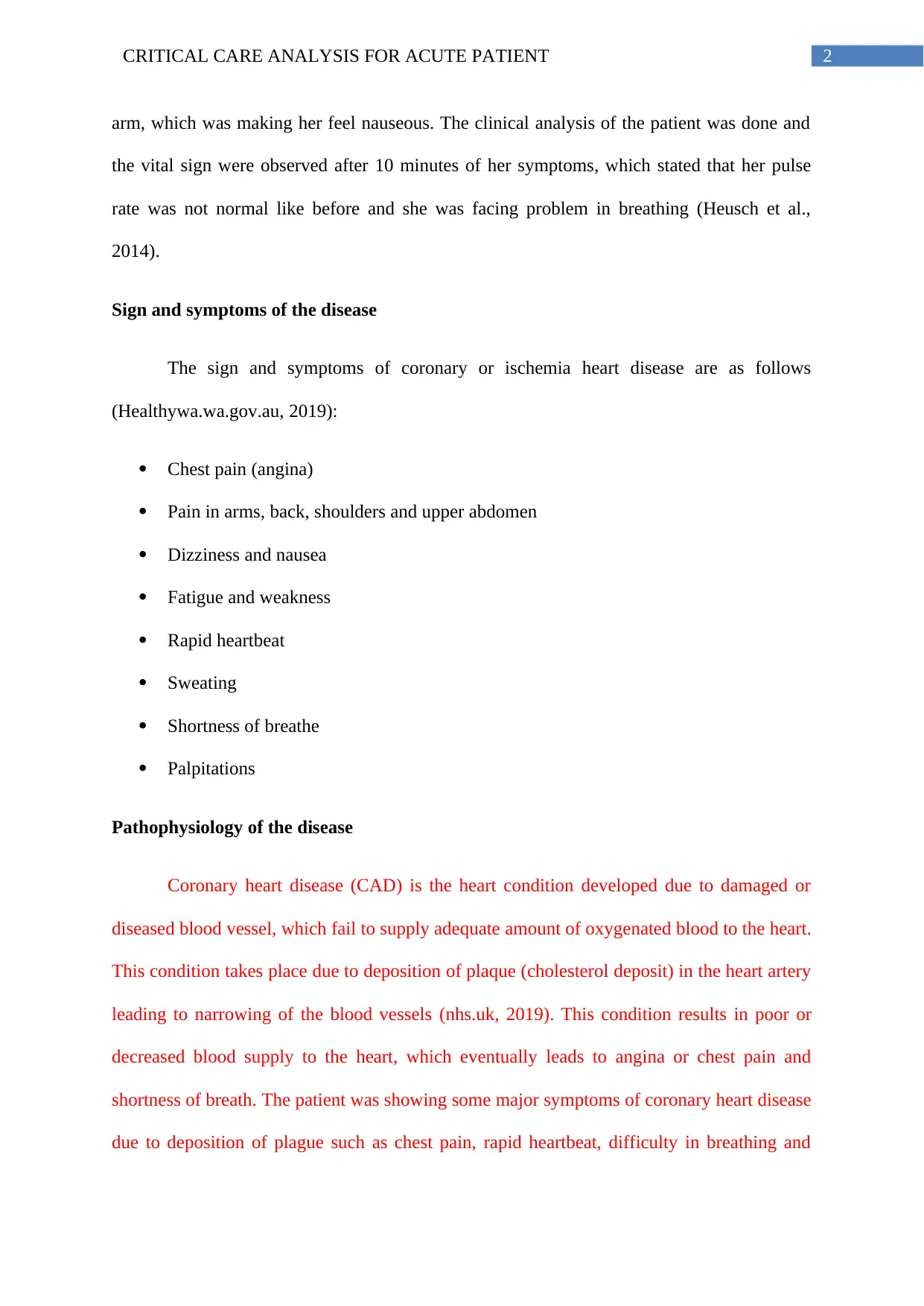
2CRITICAL CARE ANALYSIS FOR ACUTE PATIENT
arm, which was making her feel nauseous. The clinical analysis of the patient was done and
the vital sign were observed after 10 minutes of her symptoms, which stated that her pulse
rate was not normal like before and she was facing problem in breathing (Heusch et al.,
2014).
Sign and symptoms of the disease
The sign and symptoms of coronary or ischemia heart disease are as follows
(Healthywa.wa.gov.au, 2019):
Chest pain (angina)
Pain in arms, back, shoulders and upper abdomen
Dizziness and nausea
Fatigue and weakness
Rapid heartbeat
Sweating
Shortness of breathe
Palpitations
Pathophysiology of the disease
Coronary heart disease (CAD) is the heart condition developed due to damaged or
diseased blood vessel, which fail to supply adequate amount of oxygenated blood to the heart.
This condition takes place due to deposition of plaque (cholesterol deposit) in the heart artery
leading to narrowing of the blood vessels (nhs.uk, 2019). This condition results in poor or
decreased blood supply to the heart, which eventually leads to angina or chest pain and
shortness of breath. The patient was showing some major symptoms of coronary heart disease
due to deposition of plague such as chest pain, rapid heartbeat, difficulty in breathing and
arm, which was making her feel nauseous. The clinical analysis of the patient was done and
the vital sign were observed after 10 minutes of her symptoms, which stated that her pulse
rate was not normal like before and she was facing problem in breathing (Heusch et al.,
2014).
Sign and symptoms of the disease
The sign and symptoms of coronary or ischemia heart disease are as follows
(Healthywa.wa.gov.au, 2019):
Chest pain (angina)
Pain in arms, back, shoulders and upper abdomen
Dizziness and nausea
Fatigue and weakness
Rapid heartbeat
Sweating
Shortness of breathe
Palpitations
Pathophysiology of the disease
Coronary heart disease (CAD) is the heart condition developed due to damaged or
diseased blood vessel, which fail to supply adequate amount of oxygenated blood to the heart.
This condition takes place due to deposition of plaque (cholesterol deposit) in the heart artery
leading to narrowing of the blood vessels (nhs.uk, 2019). This condition results in poor or
decreased blood supply to the heart, which eventually leads to angina or chest pain and
shortness of breath. The patient was showing some major symptoms of coronary heart disease
due to deposition of plague such as chest pain, rapid heartbeat, difficulty in breathing and
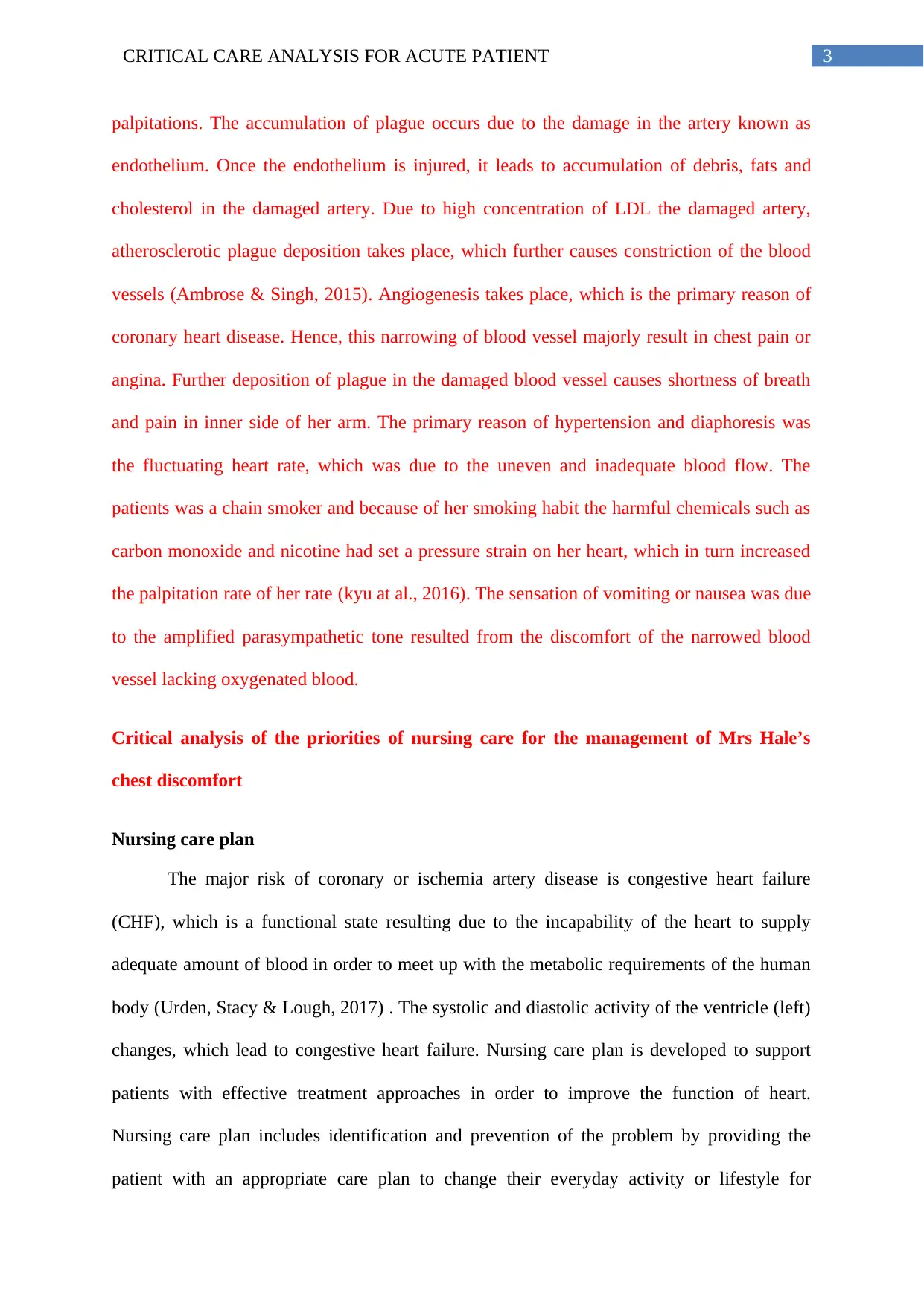
3CRITICAL CARE ANALYSIS FOR ACUTE PATIENT
palpitations. The accumulation of plague occurs due to the damage in the artery known as
endothelium. Once the endothelium is injured, it leads to accumulation of debris, fats and
cholesterol in the damaged artery. Due to high concentration of LDL the damaged artery,
atherosclerotic plague deposition takes place, which further causes constriction of the blood
vessels (Ambrose & Singh, 2015). Angiogenesis takes place, which is the primary reason of
coronary heart disease. Hence, this narrowing of blood vessel majorly result in chest pain or
angina. Further deposition of plague in the damaged blood vessel causes shortness of breath
and pain in inner side of her arm. The primary reason of hypertension and diaphoresis was
the fluctuating heart rate, which was due to the uneven and inadequate blood flow. The
patients was a chain smoker and because of her smoking habit the harmful chemicals such as
carbon monoxide and nicotine had set a pressure strain on her heart, which in turn increased
the palpitation rate of her rate (kyu at al., 2016). The sensation of vomiting or nausea was due
to the amplified parasympathetic tone resulted from the discomfort of the narrowed blood
vessel lacking oxygenated blood.
Critical analysis of the priorities of nursing care for the management of Mrs Hale’s
chest discomfort
Nursing care plan
The major risk of coronary or ischemia artery disease is congestive heart failure
(CHF), which is a functional state resulting due to the incapability of the heart to supply
adequate amount of blood in order to meet up with the metabolic requirements of the human
body (Urden, Stacy & Lough, 2017) . The systolic and diastolic activity of the ventricle (left)
changes, which lead to congestive heart failure. Nursing care plan is developed to support
patients with effective treatment approaches in order to improve the function of heart.
Nursing care plan includes identification and prevention of the problem by providing the
patient with an appropriate care plan to change their everyday activity or lifestyle for
palpitations. The accumulation of plague occurs due to the damage in the artery known as
endothelium. Once the endothelium is injured, it leads to accumulation of debris, fats and
cholesterol in the damaged artery. Due to high concentration of LDL the damaged artery,
atherosclerotic plague deposition takes place, which further causes constriction of the blood
vessels (Ambrose & Singh, 2015). Angiogenesis takes place, which is the primary reason of
coronary heart disease. Hence, this narrowing of blood vessel majorly result in chest pain or
angina. Further deposition of plague in the damaged blood vessel causes shortness of breath
and pain in inner side of her arm. The primary reason of hypertension and diaphoresis was
the fluctuating heart rate, which was due to the uneven and inadequate blood flow. The
patients was a chain smoker and because of her smoking habit the harmful chemicals such as
carbon monoxide and nicotine had set a pressure strain on her heart, which in turn increased
the palpitation rate of her rate (kyu at al., 2016). The sensation of vomiting or nausea was due
to the amplified parasympathetic tone resulted from the discomfort of the narrowed blood
vessel lacking oxygenated blood.
Critical analysis of the priorities of nursing care for the management of Mrs Hale’s
chest discomfort
Nursing care plan
The major risk of coronary or ischemia artery disease is congestive heart failure
(CHF), which is a functional state resulting due to the incapability of the heart to supply
adequate amount of blood in order to meet up with the metabolic requirements of the human
body (Urden, Stacy & Lough, 2017) . The systolic and diastolic activity of the ventricle (left)
changes, which lead to congestive heart failure. Nursing care plan is developed to support
patients with effective treatment approaches in order to improve the function of heart.
Nursing care plan includes identification and prevention of the problem by providing the
patient with an appropriate care plan to change their everyday activity or lifestyle for
Secure Best Marks with AI Grader
Need help grading? Try our AI Grader for instant feedback on your assignments.
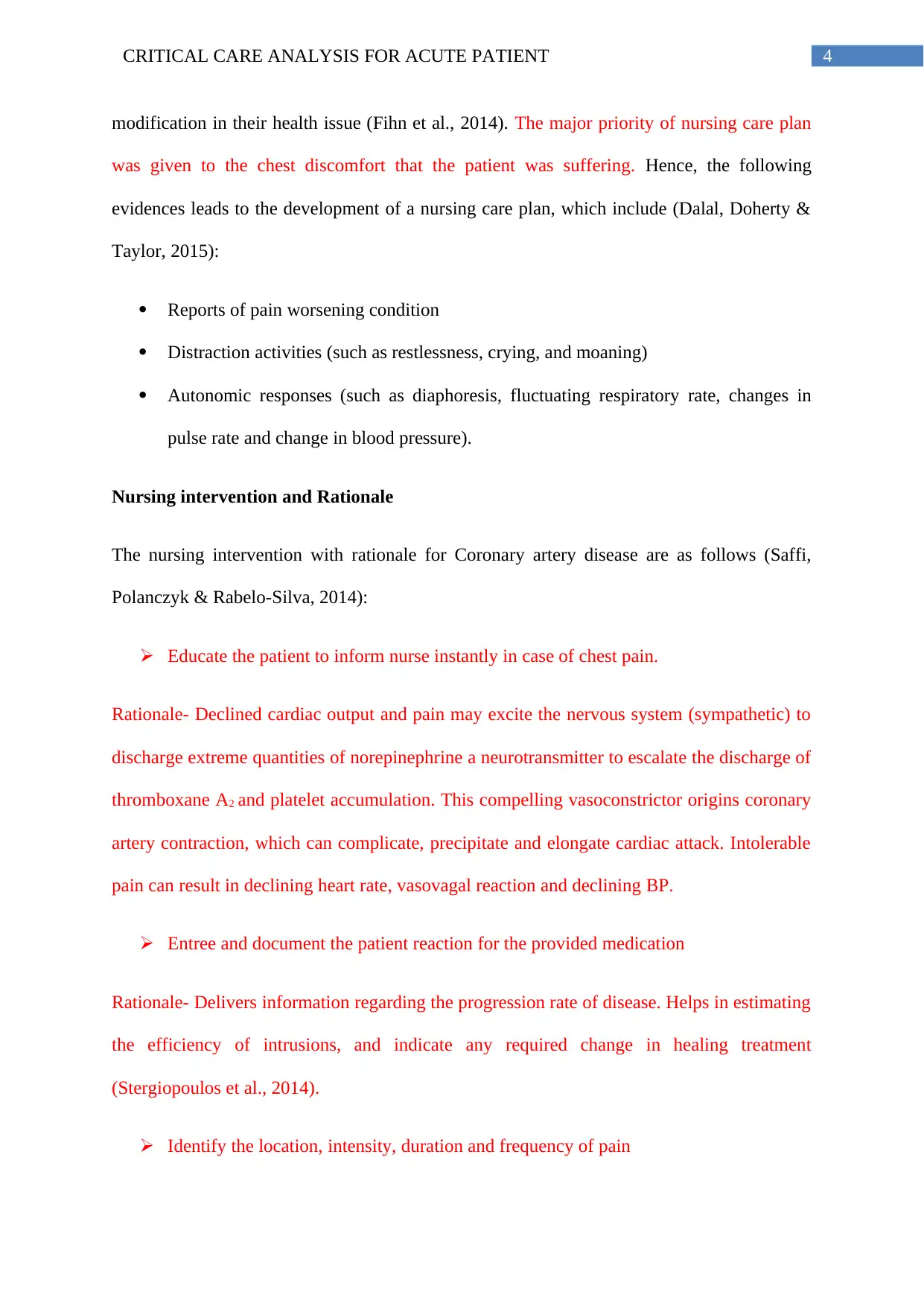
4CRITICAL CARE ANALYSIS FOR ACUTE PATIENT
modification in their health issue (Fihn et al., 2014). The major priority of nursing care plan
was given to the chest discomfort that the patient was suffering. Hence, the following
evidences leads to the development of a nursing care plan, which include (Dalal, Doherty &
Taylor, 2015):
Reports of pain worsening condition
Distraction activities (such as restlessness, crying, and moaning)
Autonomic responses (such as diaphoresis, fluctuating respiratory rate, changes in
pulse rate and change in blood pressure).
Nursing intervention and Rationale
The nursing intervention with rationale for Coronary artery disease are as follows (Saffi,
Polanczyk & Rabelo-Silva, 2014):
Educate the patient to inform nurse instantly in case of chest pain.
Rationale- Declined cardiac output and pain may excite the nervous system (sympathetic) to
discharge extreme quantities of norepinephrine a neurotransmitter to escalate the discharge of
thromboxane A2 and platelet accumulation. This compelling vasoconstrictor origins coronary
artery contraction, which can complicate, precipitate and elongate cardiac attack. Intolerable
pain can result in declining heart rate, vasovagal reaction and declining BP.
Entree and document the patient reaction for the provided medication
Rationale- Delivers information regarding the progression rate of disease. Helps in estimating
the efficiency of intrusions, and indicate any required change in healing treatment
(Stergiopoulos et al., 2014).
Identify the location, intensity, duration and frequency of pain
modification in their health issue (Fihn et al., 2014). The major priority of nursing care plan
was given to the chest discomfort that the patient was suffering. Hence, the following
evidences leads to the development of a nursing care plan, which include (Dalal, Doherty &
Taylor, 2015):
Reports of pain worsening condition
Distraction activities (such as restlessness, crying, and moaning)
Autonomic responses (such as diaphoresis, fluctuating respiratory rate, changes in
pulse rate and change in blood pressure).
Nursing intervention and Rationale
The nursing intervention with rationale for Coronary artery disease are as follows (Saffi,
Polanczyk & Rabelo-Silva, 2014):
Educate the patient to inform nurse instantly in case of chest pain.
Rationale- Declined cardiac output and pain may excite the nervous system (sympathetic) to
discharge extreme quantities of norepinephrine a neurotransmitter to escalate the discharge of
thromboxane A2 and platelet accumulation. This compelling vasoconstrictor origins coronary
artery contraction, which can complicate, precipitate and elongate cardiac attack. Intolerable
pain can result in declining heart rate, vasovagal reaction and declining BP.
Entree and document the patient reaction for the provided medication
Rationale- Delivers information regarding the progression rate of disease. Helps in estimating
the efficiency of intrusions, and indicate any required change in healing treatment
(Stergiopoulos et al., 2014).
Identify the location, intensity, duration and frequency of pain
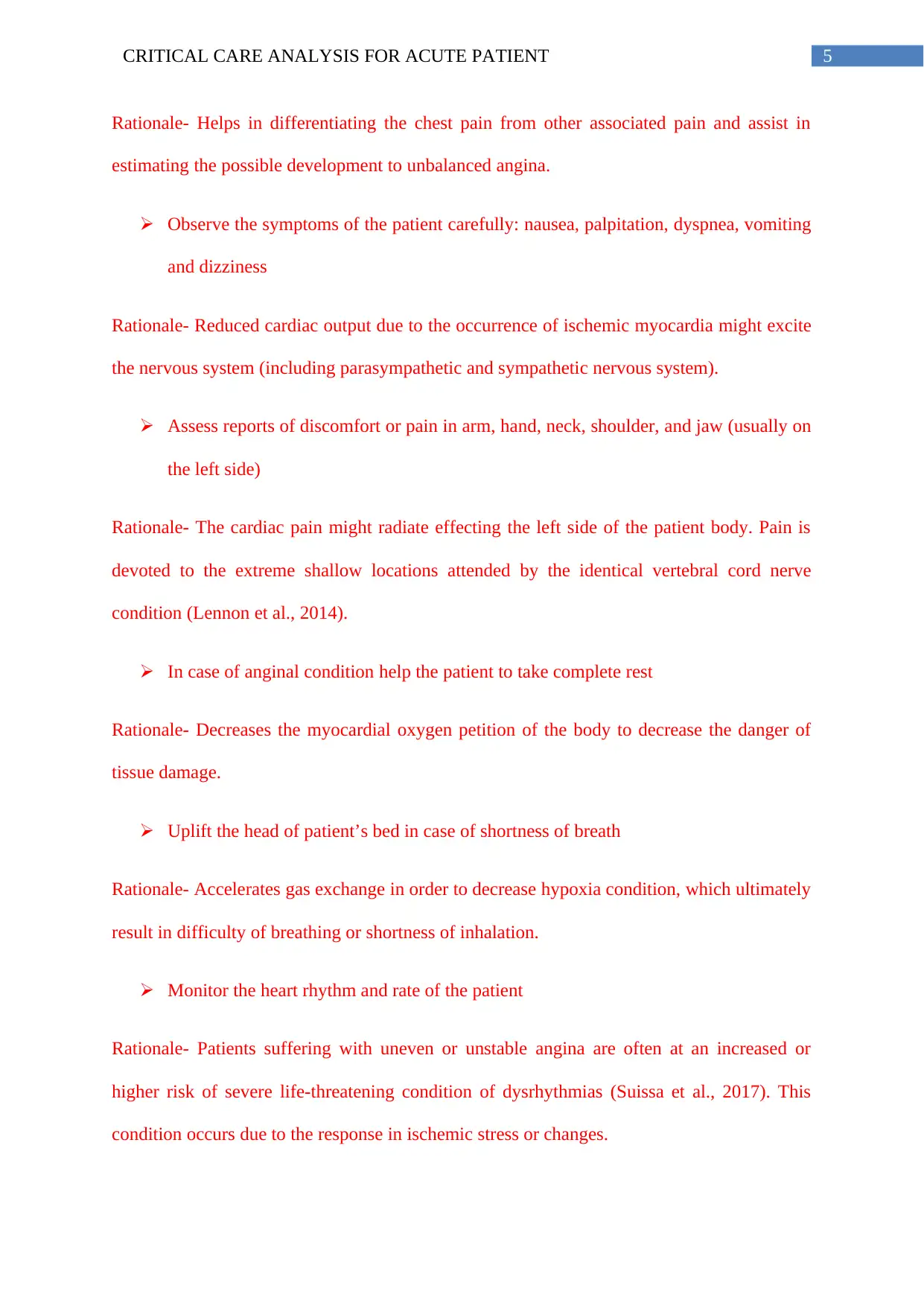
5CRITICAL CARE ANALYSIS FOR ACUTE PATIENT
Rationale- Helps in differentiating the chest pain from other associated pain and assist in
estimating the possible development to unbalanced angina.
Observe the symptoms of the patient carefully: nausea, palpitation, dyspnea, vomiting
and dizziness
Rationale- Reduced cardiac output due to the occurrence of ischemic myocardia might excite
the nervous system (including parasympathetic and sympathetic nervous system).
Assess reports of discomfort or pain in arm, hand, neck, shoulder, and jaw (usually on
the left side)
Rationale- The cardiac pain might radiate effecting the left side of the patient body. Pain is
devoted to the extreme shallow locations attended by the identical vertebral cord nerve
condition (Lennon et al., 2014).
In case of anginal condition help the patient to take complete rest
Rationale- Decreases the myocardial oxygen petition of the body to decrease the danger of
tissue damage.
Uplift the head of patient’s bed in case of shortness of breath
Rationale- Accelerates gas exchange in order to decrease hypoxia condition, which ultimately
result in difficulty of breathing or shortness of inhalation.
Monitor the heart rhythm and rate of the patient
Rationale- Patients suffering with uneven or unstable angina are often at an increased or
higher risk of severe life-threatening condition of dysrhythmias (Suissa et al., 2017). This
condition occurs due to the response in ischemic stress or changes.
Rationale- Helps in differentiating the chest pain from other associated pain and assist in
estimating the possible development to unbalanced angina.
Observe the symptoms of the patient carefully: nausea, palpitation, dyspnea, vomiting
and dizziness
Rationale- Reduced cardiac output due to the occurrence of ischemic myocardia might excite
the nervous system (including parasympathetic and sympathetic nervous system).
Assess reports of discomfort or pain in arm, hand, neck, shoulder, and jaw (usually on
the left side)
Rationale- The cardiac pain might radiate effecting the left side of the patient body. Pain is
devoted to the extreme shallow locations attended by the identical vertebral cord nerve
condition (Lennon et al., 2014).
In case of anginal condition help the patient to take complete rest
Rationale- Decreases the myocardial oxygen petition of the body to decrease the danger of
tissue damage.
Uplift the head of patient’s bed in case of shortness of breath
Rationale- Accelerates gas exchange in order to decrease hypoxia condition, which ultimately
result in difficulty of breathing or shortness of inhalation.
Monitor the heart rhythm and rate of the patient
Rationale- Patients suffering with uneven or unstable angina are often at an increased or
higher risk of severe life-threatening condition of dysrhythmias (Suissa et al., 2017). This
condition occurs due to the response in ischemic stress or changes.

6CRITICAL CARE ANALYSIS FOR ACUTE PATIENT
Complete monitoring of vital signs after initial cardiac attack
Rationale- The blood pressure of the patient might increase initially due to sympathetic
stimulation and then might fall in case of compromised cardiac yield. Tachycardia can also
progress in reaction to the sympathetic stimulation in the patient body. This can be continued
as a compensation rejoinder in case of fall in the total cardiac output.
Adequate care of the patient in case of anxiety and pain
Rationale- Anxiety in-patient discharges catecholamine’s, which in turn increases the
myocardial capability hence escalating ischemic pain (Saffi, Polanczyk & Rabelo-Silva,
2014). The attendance of nurse in such condition might reduce the feeling of helplessness and
fear in-patient.
The comfortable and quite environment should be maintained
Rationale- The emotional or mental stress can increases the myocardial pressure or workload.
Supplemental oxygen should be provided when required
Rationale- Higher oxygen content required for myocardial uptake in order to reverse the
condition of ischemia (Dalal, Doherty & Taylor, 2015).
Auscultate heart and breath sounds and careful attention to listen the murmurs
Rationale- S3, S4, or cracks can happen due to any medication (like beta-blockers) or due to
cardiac decomposition (Maddox et al., 2014). Progression of murmurs might disclose a
valvular reason for pain (such as mitral stenosis and aortic stenosis) or rupture of papillary
muscle.
Psychosocial issue of the patient
Complete monitoring of vital signs after initial cardiac attack
Rationale- The blood pressure of the patient might increase initially due to sympathetic
stimulation and then might fall in case of compromised cardiac yield. Tachycardia can also
progress in reaction to the sympathetic stimulation in the patient body. This can be continued
as a compensation rejoinder in case of fall in the total cardiac output.
Adequate care of the patient in case of anxiety and pain
Rationale- Anxiety in-patient discharges catecholamine’s, which in turn increases the
myocardial capability hence escalating ischemic pain (Saffi, Polanczyk & Rabelo-Silva,
2014). The attendance of nurse in such condition might reduce the feeling of helplessness and
fear in-patient.
The comfortable and quite environment should be maintained
Rationale- The emotional or mental stress can increases the myocardial pressure or workload.
Supplemental oxygen should be provided when required
Rationale- Higher oxygen content required for myocardial uptake in order to reverse the
condition of ischemia (Dalal, Doherty & Taylor, 2015).
Auscultate heart and breath sounds and careful attention to listen the murmurs
Rationale- S3, S4, or cracks can happen due to any medication (like beta-blockers) or due to
cardiac decomposition (Maddox et al., 2014). Progression of murmurs might disclose a
valvular reason for pain (such as mitral stenosis and aortic stenosis) or rupture of papillary
muscle.
Psychosocial issue of the patient
Paraphrase This Document
Need a fresh take? Get an instant paraphrase of this document with our AI Paraphraser
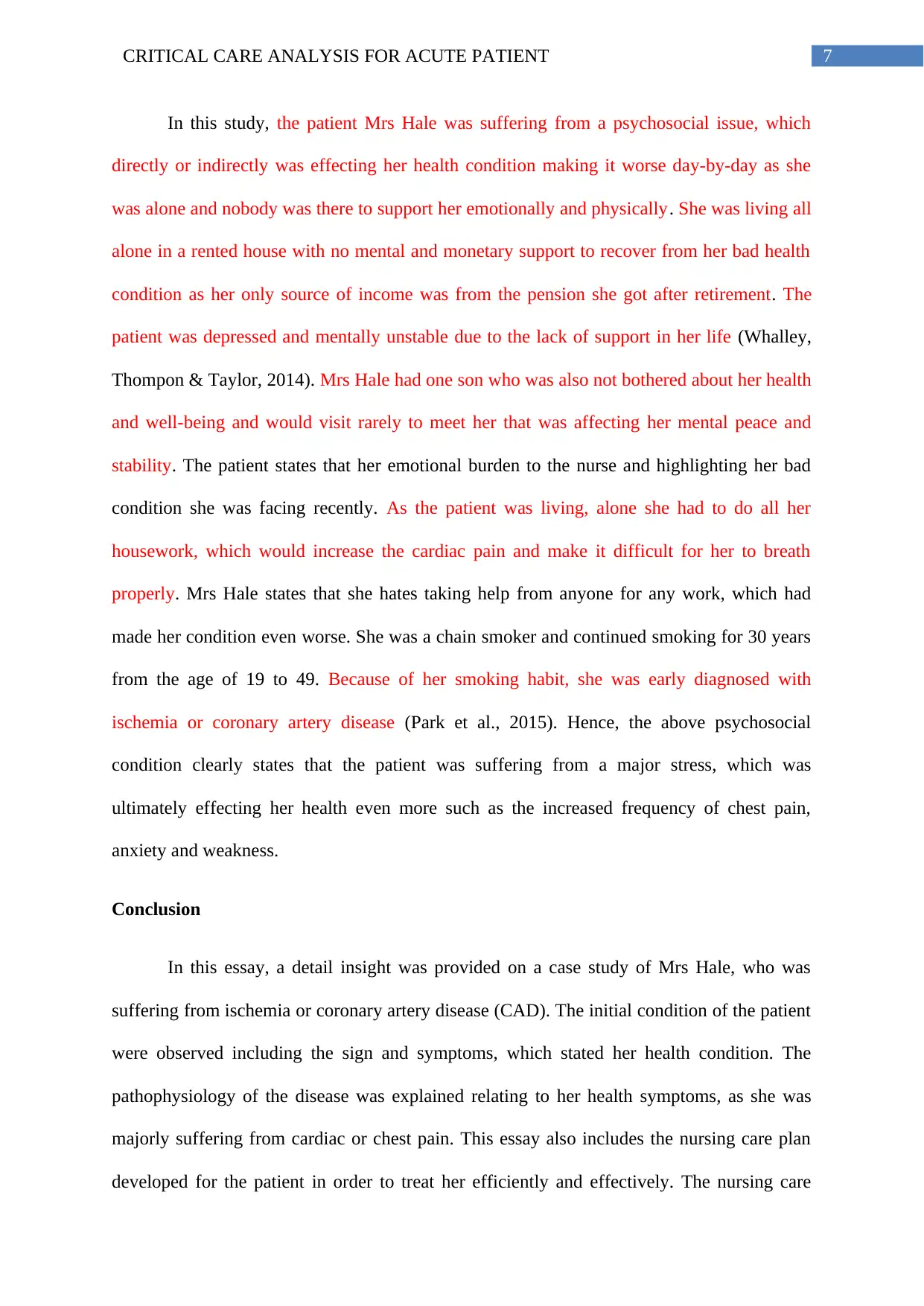
7CRITICAL CARE ANALYSIS FOR ACUTE PATIENT
In this study, the patient Mrs Hale was suffering from a psychosocial issue, which
directly or indirectly was effecting her health condition making it worse day-by-day as she
was alone and nobody was there to support her emotionally and physically. She was living all
alone in a rented house with no mental and monetary support to recover from her bad health
condition as her only source of income was from the pension she got after retirement. The
patient was depressed and mentally unstable due to the lack of support in her life (Whalley,
Thompon & Taylor, 2014). Mrs Hale had one son who was also not bothered about her health
and well-being and would visit rarely to meet her that was affecting her mental peace and
stability. The patient states that her emotional burden to the nurse and highlighting her bad
condition she was facing recently. As the patient was living, alone she had to do all her
housework, which would increase the cardiac pain and make it difficult for her to breath
properly. Mrs Hale states that she hates taking help from anyone for any work, which had
made her condition even worse. She was a chain smoker and continued smoking for 30 years
from the age of 19 to 49. Because of her smoking habit, she was early diagnosed with
ischemia or coronary artery disease (Park et al., 2015). Hence, the above psychosocial
condition clearly states that the patient was suffering from a major stress, which was
ultimately effecting her health even more such as the increased frequency of chest pain,
anxiety and weakness.
Conclusion
In this essay, a detail insight was provided on a case study of Mrs Hale, who was
suffering from ischemia or coronary artery disease (CAD). The initial condition of the patient
were observed including the sign and symptoms, which stated her health condition. The
pathophysiology of the disease was explained relating to her health symptoms, as she was
majorly suffering from cardiac or chest pain. This essay also includes the nursing care plan
developed for the patient in order to treat her efficiently and effectively. The nursing care
In this study, the patient Mrs Hale was suffering from a psychosocial issue, which
directly or indirectly was effecting her health condition making it worse day-by-day as she
was alone and nobody was there to support her emotionally and physically. She was living all
alone in a rented house with no mental and monetary support to recover from her bad health
condition as her only source of income was from the pension she got after retirement. The
patient was depressed and mentally unstable due to the lack of support in her life (Whalley,
Thompon & Taylor, 2014). Mrs Hale had one son who was also not bothered about her health
and well-being and would visit rarely to meet her that was affecting her mental peace and
stability. The patient states that her emotional burden to the nurse and highlighting her bad
condition she was facing recently. As the patient was living, alone she had to do all her
housework, which would increase the cardiac pain and make it difficult for her to breath
properly. Mrs Hale states that she hates taking help from anyone for any work, which had
made her condition even worse. She was a chain smoker and continued smoking for 30 years
from the age of 19 to 49. Because of her smoking habit, she was early diagnosed with
ischemia or coronary artery disease (Park et al., 2015). Hence, the above psychosocial
condition clearly states that the patient was suffering from a major stress, which was
ultimately effecting her health even more such as the increased frequency of chest pain,
anxiety and weakness.
Conclusion
In this essay, a detail insight was provided on a case study of Mrs Hale, who was
suffering from ischemia or coronary artery disease (CAD). The initial condition of the patient
were observed including the sign and symptoms, which stated her health condition. The
pathophysiology of the disease was explained relating to her health symptoms, as she was
majorly suffering from cardiac or chest pain. This essay also includes the nursing care plan
developed for the patient in order to treat her efficiently and effectively. The nursing care

8CRITICAL CARE ANALYSIS FOR ACUTE PATIENT
plan included the intervention, which should be followed with proper rationale justifying the
patient condition. Hence, this essay concludes that in order to recover quickly the patient had
to take proper medication and follow the nursing care plan, which will release the patient
from all emotional and mental stress that she was going through.
plan included the intervention, which should be followed with proper rationale justifying the
patient condition. Hence, this essay concludes that in order to recover quickly the patient had
to take proper medication and follow the nursing care plan, which will release the patient
from all emotional and mental stress that she was going through.

9CRITICAL CARE ANALYSIS FOR ACUTE PATIENT
References:
Aihw.gov.au. (2019). Coronary Heart Diseases. Retrieved from
https://www.aihw.gov.au/getmedia/2a44d779-bff1-4302-b129-f515e7b07842/ah16-3-
5-coronary-heart-disease.pdf.aspx
Ambrose, J. A., & Singh, M. (2015). Pathophysiology of coronary artery disease leading to
acute coronary syndromes. F1000prime reports, 7.
Dalal, H. M., Doherty, P., & Taylor, R. S. (2015). Cardiac rehabilitation. Bmj, 351, h5000.
Fihn, S. D., Blankenship, J. C., Alexander, K. P., Bittl, J. A., Byrne, J. G., Fletcher, B. J., ...
& Naidu, S. S. (2014). 2014 ACC/AHA/AATS/PCNA/SCAI/STS focused update of
the guideline for the diagnosis and management of patients with stable ischemic heart
disease. A report of the American College of Cardiology/American Heart Association
Task Force on Practice Guidelines, and the American Association for Thoracic
Surgery, Preventive Cardiovascular Nurses Association, Society for Cardiovascular
Angiography and Interventions, and Society of Thoracic Surgeons. Journal of the
American College of Cardiology, 64(18), 1929-1949.
Health.gov.au. (2019). Department of Health | Cardiovascular disease. Retrieved from
http://www.health.gov.au/internet/main/publishing.nsf/Content/chronic-cardio
Healthywa.wa.gov.au. (2019). Coronary heart disease. Retrieved from
https://healthywa.wa.gov.au/Articles/A_E/Coronary-heart-disease
Heusch, G., Libby, P., Gersh, B., Yellon, D., Böhm, M., Lopaschuk, G., & Opie, L. (2014).
Cardiovascular remodelling in coronary artery disease and heart failure. The Lancet,
383(9932), 1933-1943.
References:
Aihw.gov.au. (2019). Coronary Heart Diseases. Retrieved from
https://www.aihw.gov.au/getmedia/2a44d779-bff1-4302-b129-f515e7b07842/ah16-3-
5-coronary-heart-disease.pdf.aspx
Ambrose, J. A., & Singh, M. (2015). Pathophysiology of coronary artery disease leading to
acute coronary syndromes. F1000prime reports, 7.
Dalal, H. M., Doherty, P., & Taylor, R. S. (2015). Cardiac rehabilitation. Bmj, 351, h5000.
Fihn, S. D., Blankenship, J. C., Alexander, K. P., Bittl, J. A., Byrne, J. G., Fletcher, B. J., ...
& Naidu, S. S. (2014). 2014 ACC/AHA/AATS/PCNA/SCAI/STS focused update of
the guideline for the diagnosis and management of patients with stable ischemic heart
disease. A report of the American College of Cardiology/American Heart Association
Task Force on Practice Guidelines, and the American Association for Thoracic
Surgery, Preventive Cardiovascular Nurses Association, Society for Cardiovascular
Angiography and Interventions, and Society of Thoracic Surgeons. Journal of the
American College of Cardiology, 64(18), 1929-1949.
Health.gov.au. (2019). Department of Health | Cardiovascular disease. Retrieved from
http://www.health.gov.au/internet/main/publishing.nsf/Content/chronic-cardio
Healthywa.wa.gov.au. (2019). Coronary heart disease. Retrieved from
https://healthywa.wa.gov.au/Articles/A_E/Coronary-heart-disease
Heusch, G., Libby, P., Gersh, B., Yellon, D., Böhm, M., Lopaschuk, G., & Opie, L. (2014).
Cardiovascular remodelling in coronary artery disease and heart failure. The Lancet,
383(9932), 1933-1943.
Secure Best Marks with AI Grader
Need help grading? Try our AI Grader for instant feedback on your assignments.
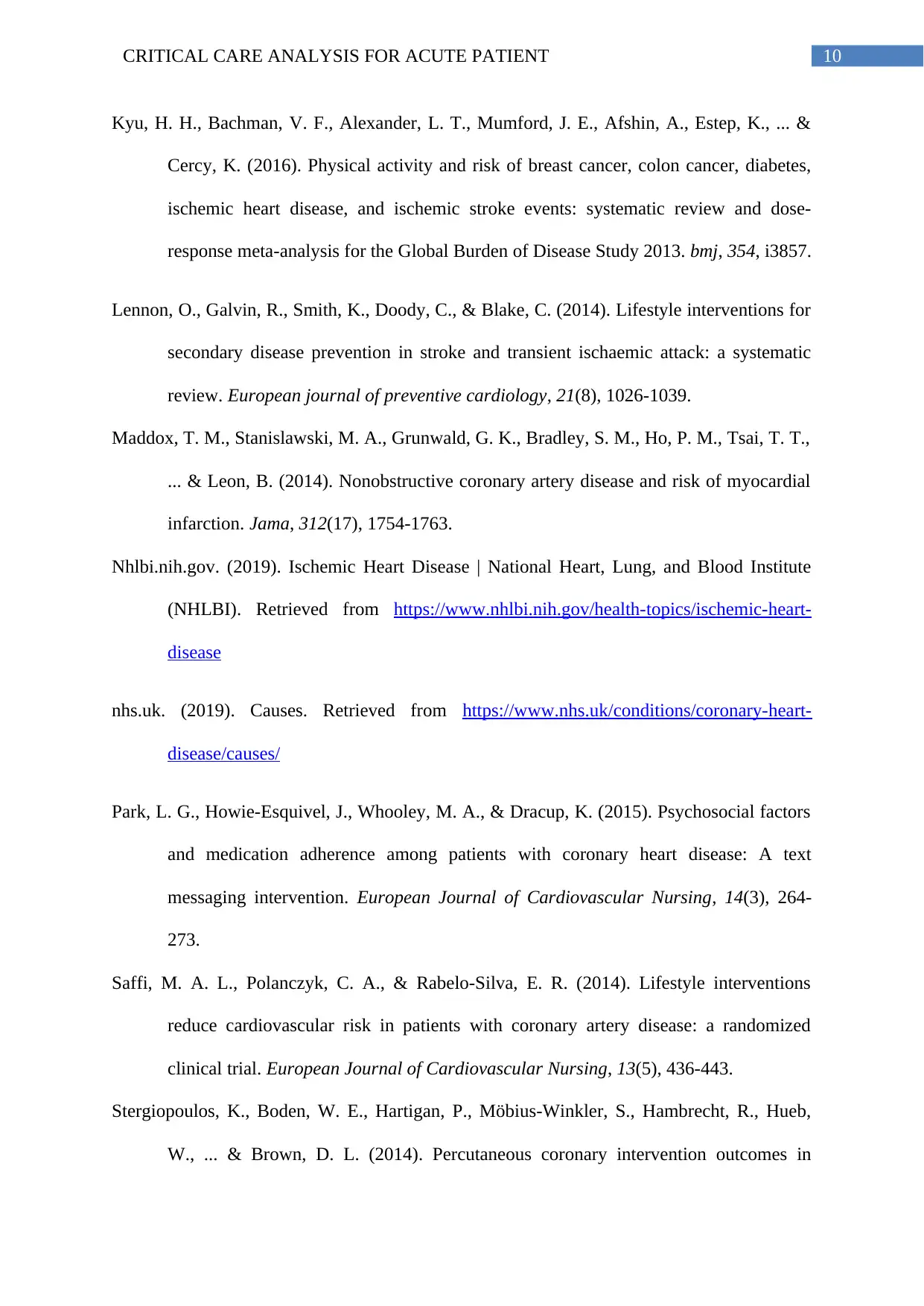
10CRITICAL CARE ANALYSIS FOR ACUTE PATIENT
Kyu, H. H., Bachman, V. F., Alexander, L. T., Mumford, J. E., Afshin, A., Estep, K., ... &
Cercy, K. (2016). Physical activity and risk of breast cancer, colon cancer, diabetes,
ischemic heart disease, and ischemic stroke events: systematic review and dose-
response meta-analysis for the Global Burden of Disease Study 2013. bmj, 354, i3857.
Lennon, O., Galvin, R., Smith, K., Doody, C., & Blake, C. (2014). Lifestyle interventions for
secondary disease prevention in stroke and transient ischaemic attack: a systematic
review. European journal of preventive cardiology, 21(8), 1026-1039.
Maddox, T. M., Stanislawski, M. A., Grunwald, G. K., Bradley, S. M., Ho, P. M., Tsai, T. T.,
... & Leon, B. (2014). Nonobstructive coronary artery disease and risk of myocardial
infarction. Jama, 312(17), 1754-1763.
Nhlbi.nih.gov. (2019). Ischemic Heart Disease | National Heart, Lung, and Blood Institute
(NHLBI). Retrieved from https://www.nhlbi.nih.gov/health-topics/ischemic-heart-
disease
nhs.uk. (2019). Causes. Retrieved from https://www.nhs.uk/conditions/coronary-heart-
disease/causes/
Park, L. G., Howie-Esquivel, J., Whooley, M. A., & Dracup, K. (2015). Psychosocial factors
and medication adherence among patients with coronary heart disease: A text
messaging intervention. European Journal of Cardiovascular Nursing, 14(3), 264-
273.
Saffi, M. A. L., Polanczyk, C. A., & Rabelo-Silva, E. R. (2014). Lifestyle interventions
reduce cardiovascular risk in patients with coronary artery disease: a randomized
clinical trial. European Journal of Cardiovascular Nursing, 13(5), 436-443.
Stergiopoulos, K., Boden, W. E., Hartigan, P., Möbius-Winkler, S., Hambrecht, R., Hueb,
W., ... & Brown, D. L. (2014). Percutaneous coronary intervention outcomes in
Kyu, H. H., Bachman, V. F., Alexander, L. T., Mumford, J. E., Afshin, A., Estep, K., ... &
Cercy, K. (2016). Physical activity and risk of breast cancer, colon cancer, diabetes,
ischemic heart disease, and ischemic stroke events: systematic review and dose-
response meta-analysis for the Global Burden of Disease Study 2013. bmj, 354, i3857.
Lennon, O., Galvin, R., Smith, K., Doody, C., & Blake, C. (2014). Lifestyle interventions for
secondary disease prevention in stroke and transient ischaemic attack: a systematic
review. European journal of preventive cardiology, 21(8), 1026-1039.
Maddox, T. M., Stanislawski, M. A., Grunwald, G. K., Bradley, S. M., Ho, P. M., Tsai, T. T.,
... & Leon, B. (2014). Nonobstructive coronary artery disease and risk of myocardial
infarction. Jama, 312(17), 1754-1763.
Nhlbi.nih.gov. (2019). Ischemic Heart Disease | National Heart, Lung, and Blood Institute
(NHLBI). Retrieved from https://www.nhlbi.nih.gov/health-topics/ischemic-heart-
disease
nhs.uk. (2019). Causes. Retrieved from https://www.nhs.uk/conditions/coronary-heart-
disease/causes/
Park, L. G., Howie-Esquivel, J., Whooley, M. A., & Dracup, K. (2015). Psychosocial factors
and medication adherence among patients with coronary heart disease: A text
messaging intervention. European Journal of Cardiovascular Nursing, 14(3), 264-
273.
Saffi, M. A. L., Polanczyk, C. A., & Rabelo-Silva, E. R. (2014). Lifestyle interventions
reduce cardiovascular risk in patients with coronary artery disease: a randomized
clinical trial. European Journal of Cardiovascular Nursing, 13(5), 436-443.
Stergiopoulos, K., Boden, W. E., Hartigan, P., Möbius-Winkler, S., Hambrecht, R., Hueb,
W., ... & Brown, D. L. (2014). Percutaneous coronary intervention outcomes in
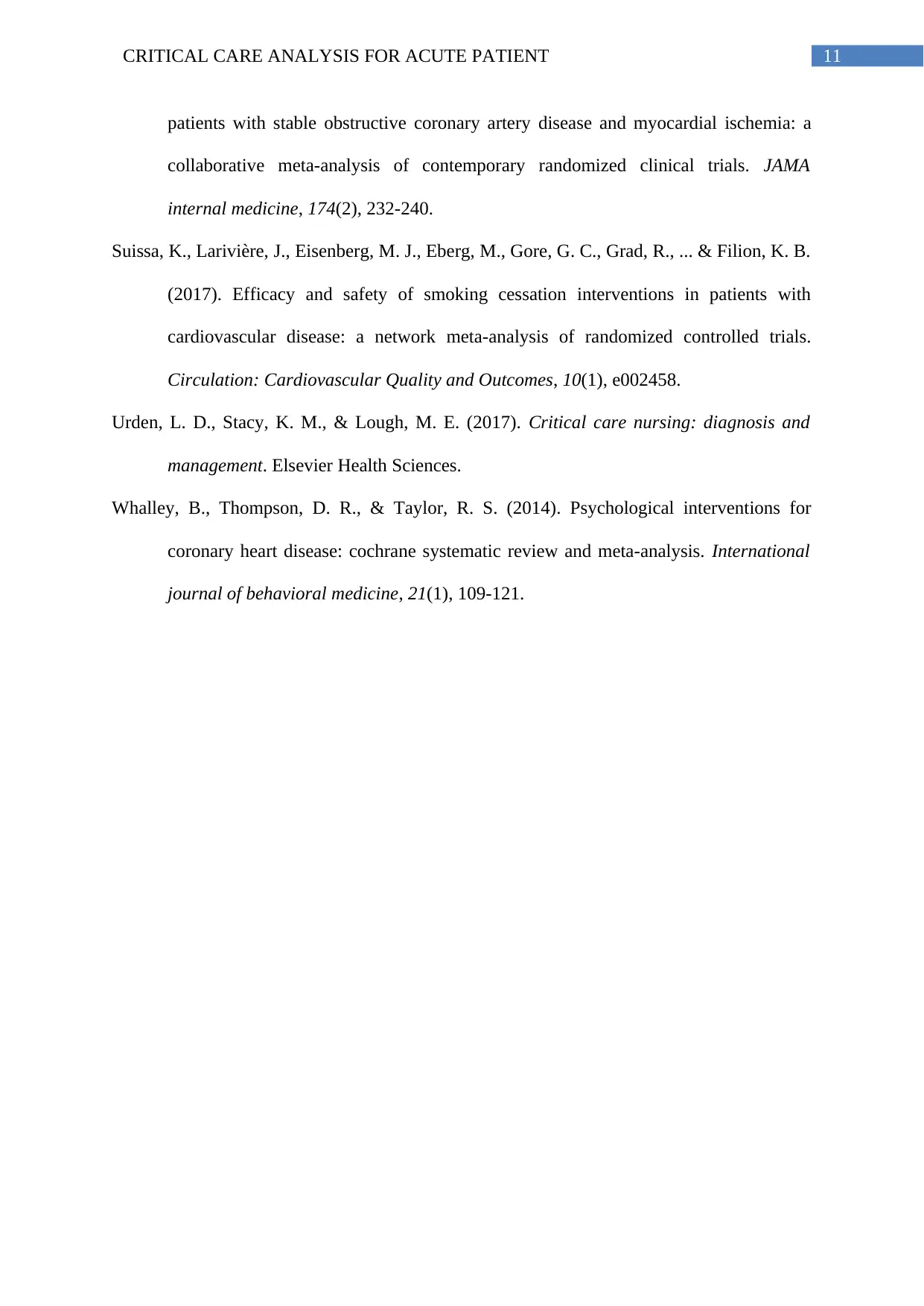
11CRITICAL CARE ANALYSIS FOR ACUTE PATIENT
patients with stable obstructive coronary artery disease and myocardial ischemia: a
collaborative meta-analysis of contemporary randomized clinical trials. JAMA
internal medicine, 174(2), 232-240.
Suissa, K., Larivière, J., Eisenberg, M. J., Eberg, M., Gore, G. C., Grad, R., ... & Filion, K. B.
(2017). Efficacy and safety of smoking cessation interventions in patients with
cardiovascular disease: a network meta-analysis of randomized controlled trials.
Circulation: Cardiovascular Quality and Outcomes, 10(1), e002458.
Urden, L. D., Stacy, K. M., & Lough, M. E. (2017). Critical care nursing: diagnosis and
management. Elsevier Health Sciences.
Whalley, B., Thompson, D. R., & Taylor, R. S. (2014). Psychological interventions for
coronary heart disease: cochrane systematic review and meta-analysis. International
journal of behavioral medicine, 21(1), 109-121.
patients with stable obstructive coronary artery disease and myocardial ischemia: a
collaborative meta-analysis of contemporary randomized clinical trials. JAMA
internal medicine, 174(2), 232-240.
Suissa, K., Larivière, J., Eisenberg, M. J., Eberg, M., Gore, G. C., Grad, R., ... & Filion, K. B.
(2017). Efficacy and safety of smoking cessation interventions in patients with
cardiovascular disease: a network meta-analysis of randomized controlled trials.
Circulation: Cardiovascular Quality and Outcomes, 10(1), e002458.
Urden, L. D., Stacy, K. M., & Lough, M. E. (2017). Critical care nursing: diagnosis and
management. Elsevier Health Sciences.
Whalley, B., Thompson, D. R., & Taylor, R. S. (2014). Psychological interventions for
coronary heart disease: cochrane systematic review and meta-analysis. International
journal of behavioral medicine, 21(1), 109-121.
1 out of 12
Related Documents
Your All-in-One AI-Powered Toolkit for Academic Success.
+13062052269
info@desklib.com
Available 24*7 on WhatsApp / Email
![[object Object]](/_next/static/media/star-bottom.7253800d.svg)
Unlock your academic potential
© 2024 | Zucol Services PVT LTD | All rights reserved.





